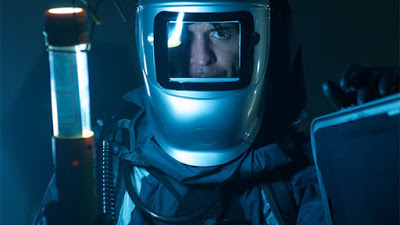The time travel themed science fiction film Synchronicity screens this evening at the Toronto After Dark Film Festival. The film is directed by Jacob Gentry, who was previously known for the 2007 horror film The Signal, as well as the My Super Psycho Sweet 16 trilogy. When Synchronicity had its world premiere this past summer at the Fantasia International Film Festival, I sat down with Jacob Gentry, producer Christopher Alender, actors Chad McKnight and AJ Bowen, and composer Ben Lovett to discuss the film.
According to Jacob Gentry, the concept for Synchronicity was conceived simply from the notion of seeing a relationship from two different points of view, with him also stating that a lot of research went into the preparation of this time travel heavy film. “We worked with this group called the Science and Entertainment Exchange and they paired us with this cosmologist named Sean Carroll, who is one of the more prominent physicists out there right now and he vetted the script basically,” says Gentry. “I talked to him, looked at the script, did a lot of research, just try and make as much real world sense, just so if actual physicists saw the movie, their ears wouldnt bleed from the science.” Gentry also makes note of the fact that he wanted to separate the time travel in Synchronicity from the typical fantastical movie time travel and have it a bit more grounded in hard science fiction.
In fact, when it came to visualizing the wormhole for time travelling in the film, Gentry decided to go in a very unique direction, which separates Synchronicity from previous films such as Stargate. “We found this artist named Kim Pimmel, who had done all this interesting macrophotography in petri dishes with inks,” says Gentry of the design for the wormhole. “So, it wasnt digital, it was actual photography of microscopic things that look like outer space.” These images work in conjunction with the film’s score by Ben Lovett, which was recorded with old vintage analogue synthesizers. “They are kind of old and you have to do things the long way,” says Lovett of the synthesizers. “It was sort of a way to try to employ some of the same tactics they were using on set with in-camera effects.”
The biggest acting challenge in the film came from actor Chad McKnight as the lead character of Jim, who spends much of the film playing two different versions of himself from various time periods. “It was hard,” says McKnight. “Honestly, I wish I could have done more. I was trying to keep it simple, without it being too moody and self-involved.” McKnight goes on to say that he often would spend the night before figuring out what pages they were shooting and that it was ultimately the wardrobe, which helped to tell him which version of Jim he was playing on a particular shooting day.
Acting alongside Chad McKnight for much of the film was AJ Bowen as fellow scientist Chuck. One thing that Bowen notes helped out on the production is that a lot of the cast and crew have already worked together, which helps to bypass the need to get to know each other. “Some of us had known each other for 30 years and that enables us to be able to make choices,” says Bowen. “In the period of time weve been working, the whole idea, the whole ambition, at least for me, is that we get more efficient with making those choices, so that more times than not, those are the correct choices. But, were always willing to pull the trigger and go its time to do this and its time to do that, because theres no time in the film to have a huge long discussion.” The film’s producer Christopher Alender adds that there are no wrong choices to make in this process, as long as everybody is making them together.
With Synchronicity featuring some very heavy time travel concepts, it can be very easy for the audience to get lost within the plot of the film. Christopher Alender states that a fair amount of attention was placed on trying to avoid such a confusion. “Underneath it all, its all kind of figured out pretty well, but we didnt want to bombard people with that stuff, because its more about the characters,” says Alender. “We put a lot of work into it just making it as clean as possible, because its always messy with time travel stuff.” Chad McKnight also notes that because his character is often confused, the audience can feel forgiven if they aren’t following along either. “Were all in this together, instead of like insulting them going Dont you know where we are in this movie?”
Synchronicity is a film that rewards repeat viewings, with the audience being able to pick up visual cues that they missed the first time around. Jacob Gentry also notes that the use of real science in the film helps to get around certain paradoxes and brain-busters. “These are concepts that are legitimately considered and theorized about in the community and it also helps with the story,” says Gentry. “Thats what also separates it from other time travel movies too, in a lot of ways.”
Synchronicity is also a film that holds its inspirations on its sleeves, with many of the visual inspirations also inspiring Ben Lovett’s score for the film. However, Lovett notes that there will be those who see these inspirations with fresh eyes. “Theres a whole generation of kids who will probably see this movie, who dont have those reference points, so maybe they will be interested to go back and see where that stuff came from.”
Synchronicity screens as part of Toronto After Dark’s Sci-Fi Night this evening at 7:00 PM at the Scotiabank Theatre






